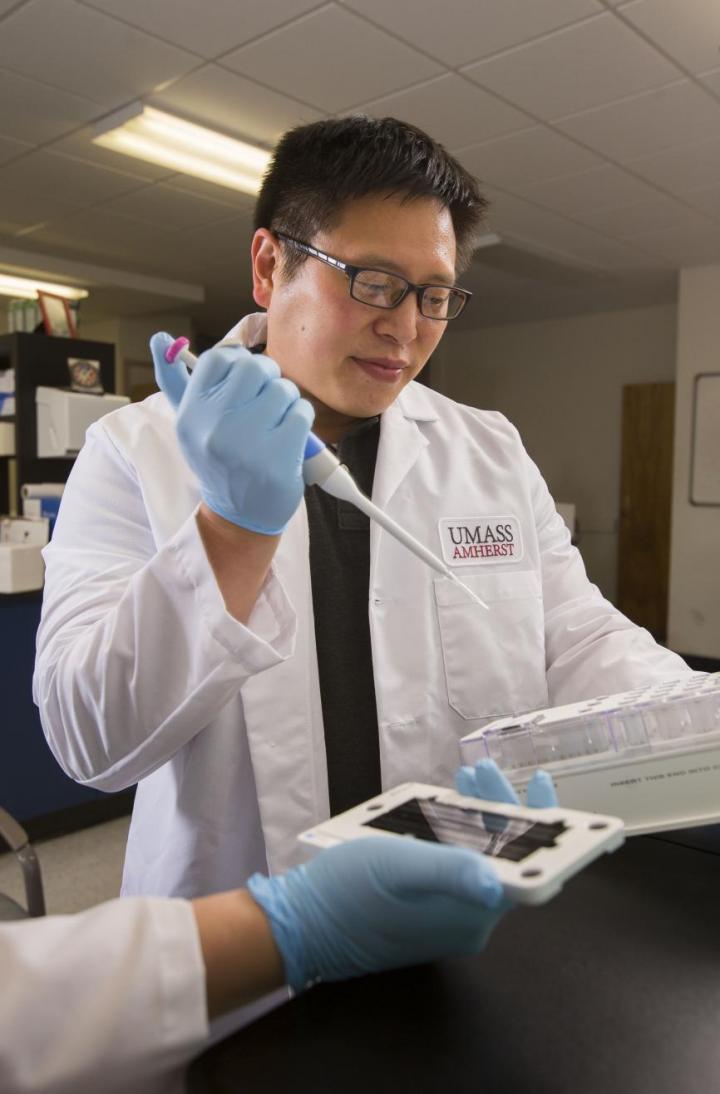New findings on how stress leads to pathway diversion, putting resources into growth

Credit: UMass Amherst
AMHERST, Mass. – In an unexpected new finding, biochemists at the University of Massachusetts Amherst report observing that a damage-containment system in stressed bacteria can become overrun and blocked, but that this leads to cells responding by turning on very different pathways to make sure that normal growth continues.
Rilee Zeinert, a doctoral student in the Molecular and Cell Biology Program and his advisor, professor Peter Chien, report on their recent experiments and discovery about how bacteria switch gears to respond to different stresses but still maintain normal cell functions like DNA replication in the recent issue of the Cell journal, Molecular Cell. Other contributing authors include Benjamin Tu and Hamid Baniasadi at the University of Texas Southwestern Medical Center.
Chien says that because all cells must maintain normal growth even during stressful conditions and all cells contain clean-up proteases that degrade used proteins and other waste, similar regulation may be at work in other biological responses. He suggests, “Cancer cells also are constantly growing under protein stress conditions, so understanding how cells in general take advantage of protease competition to respond to stress leads to tempting speculations that we can inhibit similar pathways to block uncontrolled growth.”
In bacteria, a protease known as Lon destroys damaged proteins to protect cells from their toxic consequences and degrades normal signaling proteins, as well. Stress that is toxic to proteins – causing misfolding, for example – prompts the bacteria not only to try to keep removing these damaged proteins, but to maintain processes like replicating DNA for normal growth. Zeinert studied the Lon protease and pathways it uses during cell stress, such as antibiotic attacks or extreme heat, to accomplish this.
In their new paper, the authors show that when bacteria are stressed, the increase in damaged proteins ends up temporarily swamping the Lon protease. This results in stabilization of signaling proteins that would normally be degraded by Lon, which sets off a cascade of responses, Chien explains.
He adds, “The misfolded proteins are canaries in the coal mines. When they build up so much that Lon is now blocked, the cells respond by turning on pathways needed to ensure growth.” In particular, the cells increase the amount of deoxynucleotides – the ‘DN’ of DNA – building blocks that are needed for DNA replication.”
Zeinert, Chien and colleagues discovered this new pathway unexpectedly when they were exploring the essential character of different genes that depend on the Lon protease. Chien recalls, “Rilee was using a new approach that looks at the fitness cost of each gene in different mutant backgrounds. Surprisingly, he found that loss of a normally essential deoxynucleotide synthesis gene was now tolerated in cells missing the Lon protease.”
This meant that by decreasing Lon activity, cells would compensate by making more deoxynucleotides, a result the researchers confirmed with metabolomics, a procedure that measures hundreds of chemicals in a cell at once, he adds.
Chien explains, “The metabolomics told us that there was a substantial shift in all the building blocks for DNA synthesis when Lon activity was compromised. At the same time, we had seen that when cells are stressed they also seem to make more of these molecules.” That connection led the researchers to determine that it was the damaged proteins arising from the stress causing a block of Lon activity that resulted in this response.
Chien, who is director of the Models to Medicine Center in the Institute of Applied Life Sciences at UMass Amherst, points out that this work was funded by the National Institute of General Medical Sciences in the form of a MIRA grant to Chien and the Chemistry-Biology Training Program, which also supported Zeinert. The MIRA program does not fund individual projects, but broad programs of basic discovery research, to encourage researchers to propose more long-term, innovative, creative projects and to worry less about short-term goals and results.
###
Media Contact
Janet Lathrop
[email protected]
Original Source
https:/
Related Journal Article
http://dx.




